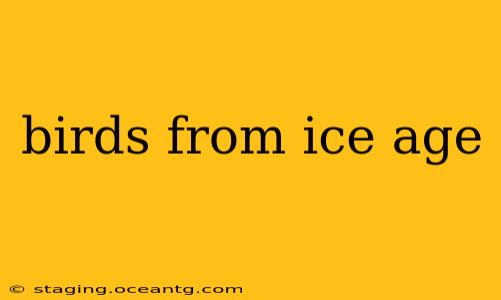The Ice Age, spanning roughly 2.6 million to 11,700 years ago, was a period of dramatic environmental shifts that profoundly impacted life on Earth. While mammoths and saber-toothed cats often steal the spotlight, the avian inhabitants of this era deserve recognition. Understanding the birds from the Ice Age offers a fascinating window into the past, revealing adaptations, extinctions, and the impact of climate change on avian evolution.
What Types of Birds Lived During the Ice Age?
The Pleistocene Epoch, the geological period encompassing most of the Ice Age, boasted a diverse array of bird species. Many were similar to birds we see today, representing ancestral lineages. However, some were entirely unique, adapted to the harsh conditions of the time. These included:
- Larger Flightless Birds: Several islands during this period, due to isolation and plentiful resources, were home to significantly larger flightless birds, similar to the modern-day kiwi or emu, but often reaching astonishing sizes.
- Specialized Predators: Birds of prey adapted to hunting the megafauna that roamed the Ice Age landscapes. These raptors likely displayed impressive hunting skills, targeting mammoths, bison, and other large mammals.
- Cold-Adapted Species: Many birds developed adaptations to survive in colder climates, such as thicker plumage or altered migration patterns.
What Birds Went Extinct During the Ice Age?
The Ice Age saw numerous extinctions, and birds were not immune. The causes are complex and likely included habitat loss due to climate change, hunting by humans, and competition with other species. Some notable extinct avian species include:
- The Dodo's Relatives: While the Dodo itself went extinct later, several of its relatives, flightless birds from islands in the Indian Ocean, perished during the Pleistocene.
- Giant Moas: These colossal flightless birds of New Zealand, some standing over 12 feet tall, disappeared during this period. Their extinction is largely attributed to human hunting.
- Various Other Flightless Birds: The extinction of flightless birds was particularly prevalent, highlighting the vulnerability of species specialized to specific environments.
Did Birds Evolve During the Ice Age?
Yes, birds undoubtedly evolved during the Ice Age. The fluctuating climates and changing landscapes created selective pressures that favored certain adaptations. This led to the evolution of new species, variations in existing lineages, and the extinction of others, all shaping the avian diversity we see today. Many of the adaptations observed focused on survival in colder temperatures and hunting megafauna.
How Do We Know About Ice Age Birds?
Our understanding of Ice Age birds comes from a variety of sources:
- Fossil Evidence: Fossil bones, eggshells, and even feathers provide direct evidence of the species that existed.
- Subfossil Remains: In some cases, bones preserved in caves or bogs haven't fully fossilized, offering additional insights into these creatures.
- Ancient DNA: Scientists can extract and analyze DNA from ancient remains to understand genetic relationships between extinct and extant species.
What Can Ice Age Birds Teach Us About Climate Change Today?
Studying Ice Age birds provides valuable insights into the impact of climate change on biodiversity. Understanding how past avian species responded to environmental shifts offers crucial information about how modern birds might react to current climate change and helps us develop conservation strategies. The extinctions of several flightless birds, for example, underscore the vulnerability of specialized species facing rapid environmental alterations.
By examining the avian fossils and studying their adaptations, we can gain a crucial understanding of how species cope with climate change, which will be critical for designing effective conservation strategies in the future. The story of Ice Age birds isn't just a glimpse into the past; it's a critical piece of the puzzle in understanding the present and shaping a more sustainable future.
